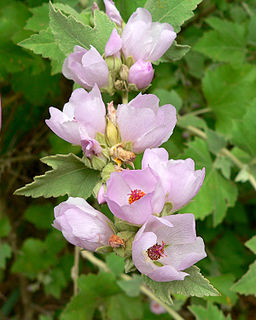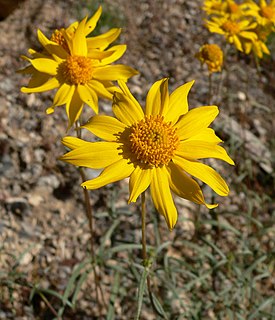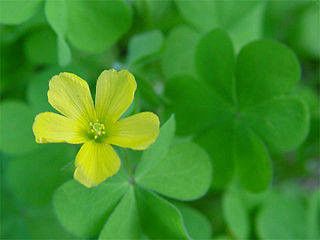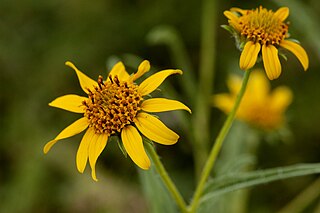
Cupressus arizonica, the Arizona cypress, is a North American species of tree in the cypress family Cupressaceae, native to the southwestern United States and Mexico. Populations may be scattered rather than in large, dense stands.

Delphinium parishii, the desert larkspur, is a flowering plant in the family Ranunculaceae native to the Mojave Desert, in the southwestern United States and northwest Mexico. In Southern California it is also found in the Tehachapi Mountains, Transverse Ranges, and eastern Sierra Nevada.

Isocoma, commonly called jimmyweed or goldenweed, is a genus of North American semi-woody shrubs in the family Asteraceae. It is found in the semi-arid areas of Southwestern United States and Mexico.

Viguiera is a genus of flowering plants in the family Asteraceae. The name honours French physician L. G. Alexandre Viguier (1790–1867). It contains around 150 species, which are commonly known as goldeneyes and are native to the New World. These are herbs to bushy shrubs that bear yellow or orange daisy-like flowers.

Fraxinus velutina, the velvet ash, Arizona ash or Modesto ash, is a species of Fraxinus native to southwestern North America, in the United States from southern California east to Texas, and in Mexico from northern Baja California east to Coahuila and Nuevo León.

Gutierrezia is a genus of flowering plants in the family Asteraceae, native to western North America and western South America. Plants of this genus are known generally as snakeweeds or matchweeds. Some species have been called greasewood. They are annual or perennial plants or subshrubs with yellow or white flowers.

Malacothamnus (bushmallow) is a genus of shrubs and subshrubs found throughout much of mainland California and on three of the Channel Islands. Outside of California, Malacothamnus is known from the northern half of Baja California, from a disjunct location in central Arizona, and possibly from a historic location that may have been in southern Arizona or adjacent Mexico. Plants of this genus are most commonly found in early-successional, post-burn plant communities. Malacothamnus are currently thought to be most closely related to the Iliamnas of the US interior and the Phymosias of Mexico, Central America, and the Caribbean.

Chaenactis is a genus of plants in the daisy family which are known generally as pincushions or dustymaidens.

Cucurbita palmata is a species of flowering plant in the squash family known by the common names coyote melon and coyote gourd. It is similar to Cucurbita californica, Cucurbita cordata, Cucurbita cylindrata, and Cucurbita digitata and all these species hybridize readily. It was first identified by Sereno Watson in 1876. These species form the only restricted xerophyte species group in the genus Cucurbita. Each member of this species group is native to the Southwestern United States and Northwestern Mexico where they are relatively uncommon. Each group member is found in hot, arid regions with low rainfall. They prefer soil that is loose, gravelly, and well-drained. C. palmata is native to northeastern Baja California, southeastern California, and southwestern Arizona to a point near the Colorado River. The juvenile leaves of C. cylindrata, C. cordata, C. digitata, and C. palmata show a high degree of similarity, but their mature leaves are visibly different, as are their root structures. C. palmata and C. digitata are sympatric, with C. palmata separating the ranges of C. digitata at the juncture of Baja California, California, and Arizona. C. palmata fruits are diffuse green mottle that turns yellow at maturity, striped, and round.

Bursera microphylla, known by the common name elephant tree in English or 'torote' in Spanish, is a tree in genus Bursera. It grows into a distinctive sculptural form, with a thickened, water-storing or caudiciform trunk. It is found in the southwestern United States and northwestern Mexico.

Heliomeris is a genus of flowering plants in the family Asteraceae known generally as false goldeneyes.

Stipa parishii, formerly classified as Achnatherum parishii, is a species of grass known by the common name Parish's needlegrass. The Jepson Manual 2nd edition (2012) reclassified the plant as Stipa parishii var. parishii.

Oxalis albicans, commonly known as radishroot woodsorrel, is North American species of perennial herbs in the woodsorrel family. It is widespread in Mexico and the southwestern United States.
Chaenactis parishii is a species of flowering plant in the daisy family known by the common name Parish's chaenactis.
Cyperus parishii is a species of sedge known by the common name Parish's flatsedge. It is native to the southwestern United States and northwestern Mexico. It grows in desert, mountain, and coastal habitat in Sonora, southwestern New Mexico, Arizona, southern Nevada and southern California. It is an annual sedge forming small clumps up to about 25 centimeters tall. The inflorescence is a spherical cluster of up to 30 reddish spikelets with a few long, leaflike bracts at the base.

Bahiopsis laciniata is a species of flowering plant in the family Asteraceae known by the common names San Diego County sunflower, San Diego viguiera and tornleaf goldeneye. It is native to the deserts and dry mountain slopes of northwestern Mexico, its distribution extending north as far as Ventura County, California.

Bahiopsis reticulata is a species of flowering plant in the family Asteraceae known by the common names netvein goldeneye and Death Valley goldeneye. It is native to the Mojave Desert of California and Nevada, where it grows in several types of dry desert habitat. Many of the populations are inside Death Valley National Park.

Bahiopsis is a genus of North American flowering plants in the tribe Heliantheae within the family Asteraceae. It is native to the southwestern United States and northwestern Mexico, with several of the species endemic to the Baja California Peninsula.

Ericameria parishii, or Parish's rabbitbrush, is a western North American species of flowering plants in the daisy family.

Heliomeris hispida is a North American species of flowering plants in the family Asteraceae called the hairy goldeneye or rough false goldeneye. It is native to the southwestern United States and also to the northern Sierra Madre Occidental of western Chihuahua and eastern Sonora in Mexico. There are a few reports of the species growing in California, but these are most likely introduced populations.

















